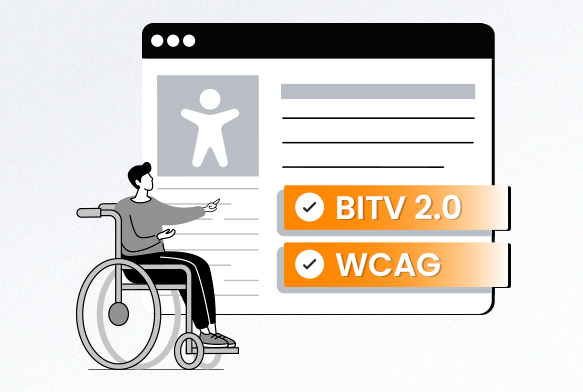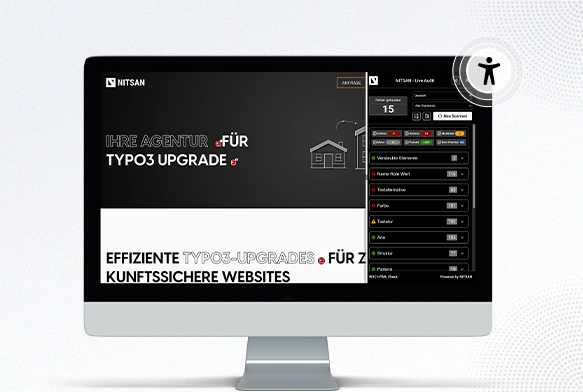Barrier-free, accessible to all
Accessibility is primarily a legal requirement under laws such as the EU Website Directive, BITV 2.0 in Germany, and WCAG guidelines, but it is also an ethical obligation. Accessible websites meet compliance requirements, improve SEO, and can reach a larger audience.
In practical terms, accessibility means ensuring that websites and applications are usable by everybody, including people with disabilities, older adults, people with limited technical skills, and people with slow internet connections.
It ensures that everyone has equitable access to information and services provided on the web, benefiting all users, but also increasing the challenge to many internet agencies.
INSIDE NITSAN
Go behind the scenes inside NITSAN for our unique TYPO3 approach, experience in TYPO3 development and our commitment to deliver quality solutions.
Stefan Reinhardt
Service Partner - Germany
+49 6204 6011377 | stefan.reinhardt@nitsantech.de
Get expert advice on accessibility
Accessibility experts provide step-by-step instructions for TYPO3 websites to support compliance with WCAG, BFSG, and BITV 2.0, so that your website works better for people with disabilities.
An important step toward a more inclusive website.
Your TYPO3 Website
Accessibility Specialist
Creating an accessible website takes technical skills and an understanding of the needs of people with diverse impairments. Legislated commitments to meeting accessibility needs, as well as the differences between sites, can make it challenging to incorporate accessibility requirements into existing systems and move content over to a new site. TYPO3 offers the flexibility and adaptability to build upon meant-to-be inclusively designed websites.
NITSAN brings its experience of accessibility and works with TYPO3 to support TYPO3 agencies in delivering digital services that are inclusively designed for all users and ensure full legal compliance.
Process to Make Accessible Website
Accessibility Standards & Guidelines
We Follow
WCAG 2.1
(Web Content Accessibility Guidelines)
An international standard for accessible digital communication that ensures a website is perceptible, operable, understandable, and robust.
BITV 2.0
(Barrierefreie-Informationstechnik-Verordnung)
National German regulation for accessible IT, which is now a requirement for all public-sector websites; this report is based on WCAG.
EU-Richtlinie zur Barrierefreiheit im Internet
Requires public sector websites and apps across the EU, including those in Germany, to meet accessibility requirements.
EN 301 549
The European accessibility standard for ICT products and services, including a website, which can be used to demonstrate compliance with the EU Directive.
BFSG
(Barrierefreiheitsstärkungsgesetz)
Germany's new law to enhance accessibility for private businesses providing digital services is mandatory by June 2025.
EAA
(Europäische Barrierefreiheitsrichtlinie)
European Union Directive for accessible digital products and services that affects the public and private sectors.
Navigation
Keyboard Access:
All interactive elements must be accessible through the keyboard using tab for navigation and enter or space for activation.
Skip Links:
Skip links help users skip long lists of menus or options and jump right to the main content.
Sitemap:
A well-structured sitemap helps with overall orientation and is useful for users with cognitive disabilities.
Forms
Labeling:
Form elements must be labelled correctly, with the labels properly linked to the fields, so that screen readers can announce them appropriately.
Error Messages:
Errors and instructions should be visual and assistive technology accessible, including clear language and helpful instructions.
FAQ’s for TYPO3 Website Accessibility
TYPO3 has a lot of benefits for agencies, especially regarding the financial costs and technical implementation of accessible websites:
Accessibility of websites means, besides many other things, that everyone, including people with disabilities, can access and use your site. As a matter of inclusivity and a better user experience overall, accessibility will help address usability issues and help you meet web and legal standards like the WCAG (Web Content Accessibility Guidelines).
Web Content Accessibility Guidelines are the standards that must be followed to make websites as accessible as possible. They cover aspects like languages used, visual components and design, semantic and functional features, and more. Following WCAG standards in a TYPO3 site can improve compliance with usability across a website design.
NITSAN starts with an audit of the website to find where any TYPO3 accessibility issues lie, followed by implementing solutions to clear up issues outlined in the audit, like compatibility with screen readers, keyboard navigation, alt text for images, accessible forms, etc.
No, as we will ensure that the TYPO3 accessibility changes will fit the design of your site. We only make your site more usable while leaving the quality of your design intact.
This will depend on the existing TYPO3 accessibility compliance of your site, and the number of changes. After an initial audit we can tell you the estimated time based on what we find on your site.
Yes, our ongoing support will maintain TYPO3 accessibility as your site continues to grow and change. It is important to periodically audit, update, and make changes to your site to ensure that all users are able to use it.
In many cases, TYPO3 accessibility and usability enhancements would also affect SEO positively, as friendly navigation, alt text, and other SEO basics also improve usability & readability. Therefore, the more accessible the site, the better the site performs overall SEO-wise.
No problem, we can provide custom solutions and meet specific accessibility needs, be it screen-reader-based, form access, or keyboard navigation improvement.
Your Accessibility Partner for TYPO3 Project
At NITSAN, we are committed to helping Internet Agencies, Web agencies, and government entities make their TYPO3 websites fully accessible.
TYPO3 Accessibility can feel complicated, but we hold your hand through every aspect of the process, audits, implementation, and everything in between, all while following the legal requirements, and at the same time improving the user experience.
With NITSAN, you can provide TYPO3 solutions that comply with legal standards while being inclusive and usable. Accessibility is not just meeting a requirement for us; it is creating lasting value for your clients and users.
Customers of NITSAN










Stefan Reinhardt
Contact for SMEs and public institutions
stefan.reinhardt@nitsantech.de|+49 6204 6011377
SAY HELLO



